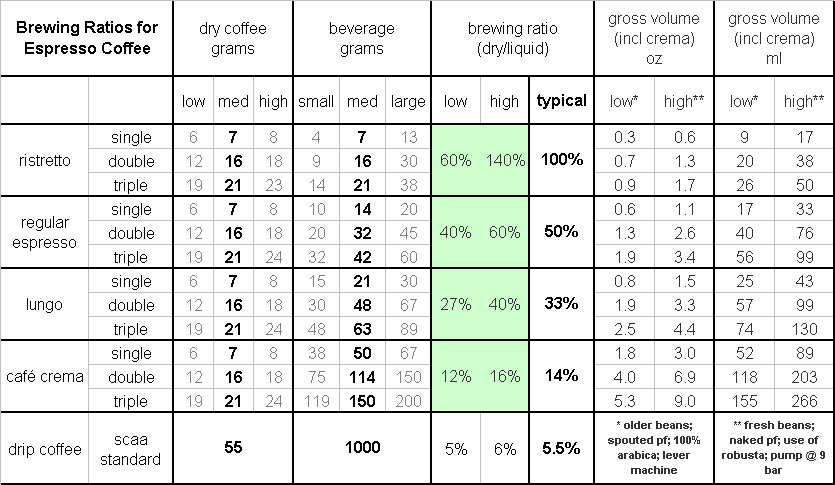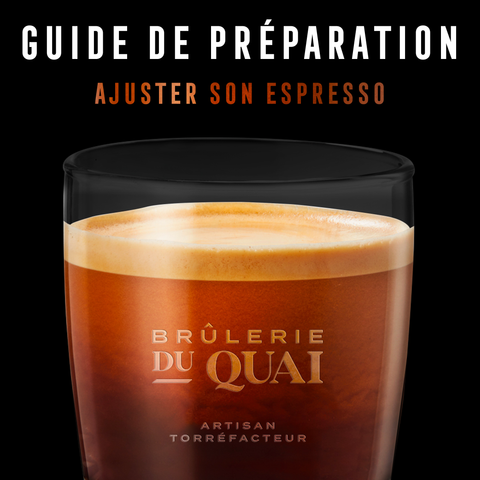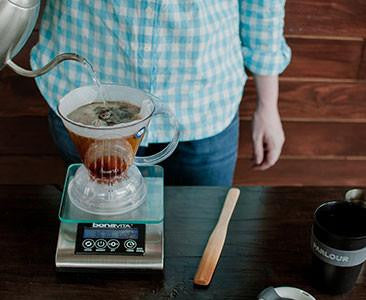
Regardless of the coffee preparation method, you will have to adjust the settings if you want to enjoy your tasting experience. And it's quite easy to get lost given the number of variables. In the case of espresso particularly, the mechanical aspect of the preparation opens the door to even more adjustment.

Here are the variable parameters of an espresso in brief:
- Quantity of ground coffee in the filter holder
- Grind grain size level
- Water temperature
- Pre-infusion time
- Extraction time
- Quantity of coffee produced (in grams)
- Ratio of coffee weight at entry / coffee weight at exit
- Dissolution rate in %
Eight parameters to adjust or measure to try to obtain the perfect espresso. No wonder it can sometimes taste bad in certain establishments if you don't take the time to understand what's going on.
Note that I also take for granted that you have chosen good coffee, fresh from your favorite roaster. The coffee aspect in itself is an element that will greatly influence the result of your espresso, but for the sake of argument, let's pretend we have a top coffee in the grinder. When I teach commercial clients, who are new to coffee, how to make a decent espresso, I always advise them to go with a method that is akin to the experimental method in science, in making a change to only one parameter at a time. This method is not perfect, because changing one parameter will undoubtedly influence the others, but it allows you to better control the changes and know where you are going. Over time, you come to understand the influence of a change on the final result and to be able to make an adjustment on the fly like a good barista must do regularly during his shift.

First of all, the first step in a new installation is to determine the dosage that will be used. So, how much coffee in grams we are going to put in the filter holder basket. Here, we must first have defined the beverage standards, and know with what quantity of espresso the beverages will be made. If you are doing this at home, ask yourself how you want to drink your coffee.
For me, even though I'm a die-hard espresso fan, I know that cappuccino and latte are the most popular drinks, so I take cappuccino as my measuring stick. It's also one of my favorite drinks and it's the one I want as an ambassador for a coffee menu.
For a 5.5oz cappuccino cup, or 163ml, I like to go with a 30-40ml espresso and top off the rest with textured milk. Yes, I make cappuccinos at 1:4 (espresso:milk) And as I like to work with the double filter holders, which will make 2 espressos at a time, I need to have a dose of coffee more important, because I will get 60 ml each time. This is why I generally use doses of 22g.
22g of coffee in the filter holder basket which will give me 2 30ml espressos, for a ratio of around 37%. My secret recipe for my cappuccino is therefore in practice around 1:4, with an espresso at 37%. If you use bottomless filter holders, the calculation is done the same way, but you will obtain “stronger” doses with a higher ratio. It's up to you to choose what you want. For my part, in a commercial environment, working with double doses is more efficient, and making a cappuccino with too high a yield or an espresso that takes too long is less pleasant to drink. It is therefore essential to determine what dose of coffee you will be working with. Once chosen, you can set this parameter and tackle the grinding degree which will give you the flow rate, and therefore the extraction time. Here, I like to start with the idea of 1ml per second. Always with the same dose of coffee at the input (and take the time to weigh your filter holder so that the doses are similar), do several tests with different grinder adjustments. And taste espresso, and also cappuccino.
You can then move on to another parameter, such as the quantity of espresso extracted in X time. Here, we fall into the seriousness of your approach, because it is at this level that your standards will be formed and that the parameters will stop moving.
The entry dose is fixed. Your grinder is adjusted for a flow rate that seems to satisfy you, all that remains is to determine the length, or rather the yield of your espressos. The formula :
100 x weight at the entrance of the coffee in g / weight of the extracted volume in g
And let the ml do it, it's too imprecise.
Let's say that with 22g, you make 62g of espresso, that gives you a ration of (22/62)x100 = 35% which is, according to the table below, a kind of elongation.
In terms of ratios, we fall into a zone of sectarian tendencies, where certain proponents of a position will try to make you believe that the only way to drink an espresso is from a ratio of 1 to you like, drinking coffee is a personal experience, to please yourself and not to be recognized.
For example, the Italian tradition has long held to the following ratio:
7g at entry / 21g at exit = 33%
The higher the %, the stronger your coffee will be, the objective being to find the ideal ratio for your tastes. The smaller the %, the more diluted your coffee will be. It's all about finding balance and you will see that an espresso with, for example, a ratio of 60% in a cappuccino is not really good. Again, it depends on the coffee, some being more soluble than others.
Then, once you have those settings set, you can play around with the water temperature, add a pre-infusion time, and see the impact on the cup. You can even use a refractometer to measure the dissolution rate and take your research even further.
And this is how, one parameter at a time, you will be able to control your extractions and have the pleasure of tasting your espresso worthy of the best alchemist!

Here is a top 5 of our coffees that are delicious as espresso:
- The Bad Boy Espresso
- The Inspiri Organic
- The Bad Girl Espresso
- Organic Italian Espresso
- The Special Cream



Comments (4)
Bonjour,
très intéressant merci de partager. Selon vous ça serait quoi un bon ratio pour un capuccino dans une tasse 9oz?
Ça m’attire l’attention votre exemple:
“par exemple un ratio de 60% dans un cappuccino n’est pas vraiment bon”
merci
Article très intéressant. Une phrase m’interpelle :
“Votre moulin est ajusté pour un débit qui semble vous satisfaire, ne reste qu’à déterminer la longueur, ou plutôt le rendement de vos espressos.”
La finesse de la mouture est certes un paramètre essentiel du débit, mais la quantité de mouture et le tassage interviennent aussi, non ? Du coup, comment peut-on régler le moulin indépendamment (et en amont) de la longueur souhaitée ?
Très intéressant ce tableau ! Cela fait près d’un an que je fais des essais d’extractions sur ma Lelit et je vois que mes paramètres idéaux se retrouvent au gramme près dans ce tableau de correspondances. La précision est bluffante ! Je vais m’en servir comme référence pour mes tests de différents grains. Etant en France, j’aurai malheureusement du mal à passer vous voir en boutique pour vous raconter tout cela !
Très utile. Merci.